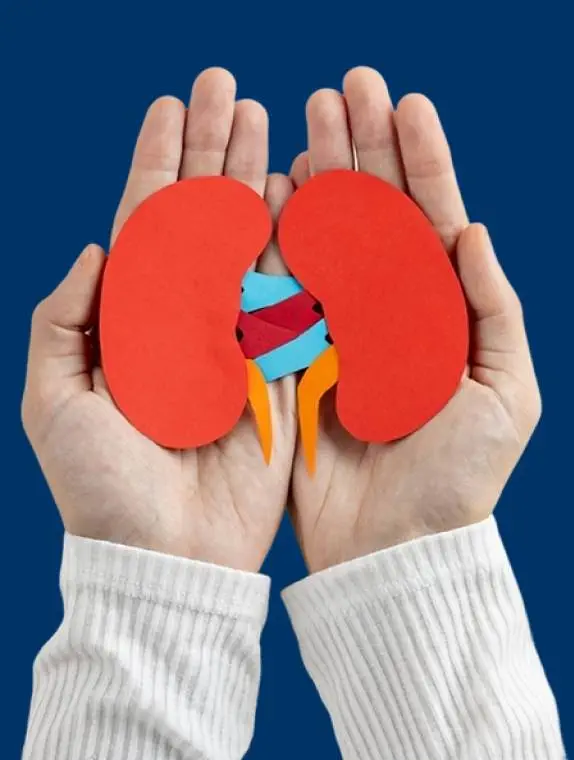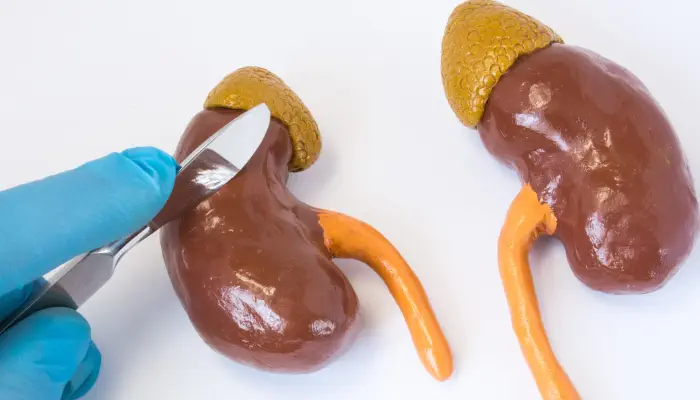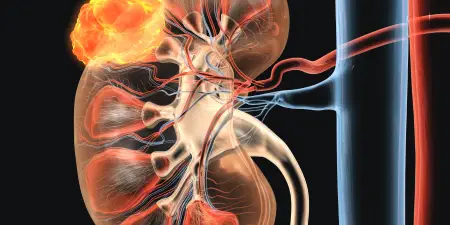Robotic-Assisted Laparoscopic Partial Nephrectomy

Partial Nephrectomy for Precise Kidney Tumour Removal
Certain kidney tumour scenarios may require precision techniques to remove the malignant tissues and preserve the good half of the organ. Such intricate procedures require a skilled expert like Dr Aarthy P, Chennai’s leading uro surgeon, who specialises in robot-assisted laparoscopic partial nephrectomy. With her surgical skills, Dr. Aarthy has helped numerous patients with kidney cancers and tumours.
As the name denotes, the surgery aims to excise only the affected portion of the kidney and leave the rest of the organ intact, thus enabling its normal function. This minimally invasive technique allows the surgeon to perform the surgery precisely and eases the recovery process. The surgery is performed through tiny laparoscopic incisions or keyholes and a 3D high-definition camera to view the surgical area.
Experience renal wellness tailored specially for you by Dr. Aarthy. Your journey to better kidney health starts here.
When is Robotic Partial Nephrectomy Necessary?
Dr. Aarthy may recommend a robotic partial nephrectomy procedure for the following medical situations:
Dealing With Kidney Tumours?
Get Help Today

- Before Surgery
- What to Expect?
- Post-Surgical Care
Robotic Partial Nephrectomy Procedure: Preparatory Guidelines
Pre-preparation is a critical part of every surgery. Here’s what you should do to make your robotic partial nephrectomy a success:
Discuss your medical history, kidney-related concerns, pre-operative tests, and surgery-related queries with your surgeon.
Complete essential blood and urine analysis tests, scans, and ECG to evaluate your physical fitness for surgery.
Follow your doctor’s advice and temporarily discontinue blood thinners as advised by your surgeon at least 2-10 days before surgery.
Continue taking all your other routine medications unless your doctor advises you to discontinue them.
Follow your doctor’s specific instructions about avoiding food and drink before your surgery and adhere to your admission schedule for the surgery.
Robotic Partial Nephrectomy: What to Expect?
The main aim of laparoscopic robotic partial nephrectomy is to remove risky kidney tumours and preserve kidney function. Here’s an approximate account of what to expect during your surgery:
A certified anaesthetist begins the procedure by administering general anaesthesia to render you fully unconscious, comfortable, and pain-free during the procedure.
Your doctor will insert a catheter into your bladder to prepare your abdominal region for the next part of your procedure.
Your surgeon will make small incisions near your belly button and insert cannulas or hollow tubes to provide access to the surgical instruments.
The advanced robotic arms are connected to the cannulas, and the instruments are inserted into the space to commence the excision.
Your doctor will inflate your abdominal cavity with gas to gain an unobstructed view of the kidney and its adjacent organs.
The problematic tumours and the blood vessels supplying the kidney are identified. The identified tumours are marked for removal.
Your surgeon will clamp the artery to restrict blood flow to the kidney for the next 15-30 minutes. This temporary blood flow restriction facilitates easy and accurate excision and repairs.
The kidney tumours are carefully detached from the organ and extricated through one of the keyhole incisions. They are bagged and sent for further pathological analysis.
Once the excision and necessary repairs are completed, your surgeon will close the incisions with absorbent sutures to minimise scarring.
After your surgery, you will be wheeled to a recovery room and closely monitored as you regain consciousness from the anaesthesia. You will be moved to the ICU or surgical ward.
Robotic Partial Nephrectomy Surgery: Post-Surgical
The success of your partial nephrectomy robotic surgery depends on your quick and wholesome recovery. Here’s what you should know about your recovery period:
You will be asked to remain in the hospital for one or two days to monitor your health and post-surgical recovery.
Your doctor will help control your spot-surgical pain with an IV pump and gradually transition you to oral painkiller medication within a day.
The nursing team will remove your catheter and abdominal drain one or two days after surgery.
Your doctor will allow you to restart your food intake, beginning with fluids immediately after surgery and a regular diet the following day.
Avoid indulging in heavy lifting sports and strenuous activities for six weeks after surgery. However, you can walk for some time to encourage blood circulation.
Schedule follow-up appointments and consult your doctor at least two to three weeks after surgery to monitor your recovery and incision healing.
Your recovery duration from the robotic nephrectomy may last for 4-6 weeks as opposed to more extended recovery periods for open surgeries.
You will need to take CT scans in the first month after surgery and after completion of one and two years to confirm that you are free from kidney tumours.
Robotic Partial Nephrectomy: The Benefits

Minimal Pain
Smaller incisions cause less post-surgical discomfort and minimise the need for pain medications.
Minimal Blood Loss
Use of a high-definition 3D camera enables crystal-clear vision and allows your doctor to to perform the surgery with pinpoint precision and minimise blood loss.
Shorter Hospitalisation
The hospitalisation duration for partial nephrectomy robotic surgery may last only for 1-3 days, depending on your health condition.
Faster Recovery
Smaller incisions, minimal intrusion, controlled blood loss, and quick-healing sutures allow you to resume your activities within one or two weeks.
Routine Life
Depending on the nature of your job, you may be able to resume your work within two to six weeks post-surgery.
Minimal Scarring
Smaller incisions lead to quick healing, less noticeable scars, and improved aesthetic results.
Surgical Precision
Enhanced visualisation of the surgical site enables precision tumour excision and suturing, thus minimising the time when blood flow to the kidney is temporarily disrupted (otherwise known as warm ischemia time).
Step Up Your Urological Health:
Schedule Your Consultation Today








